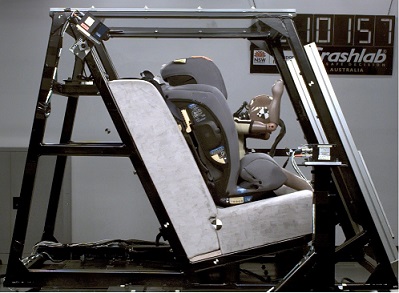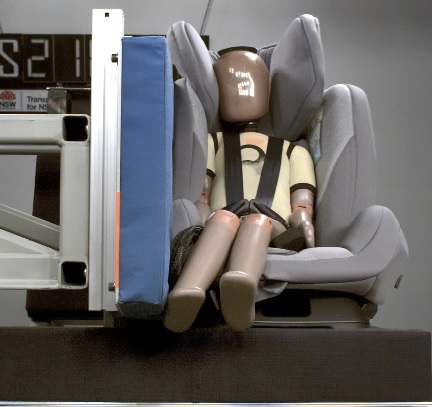Testing explained
Protection in a crash
The Child Restraint Evaluation Program (CREP) assesses the crash protection performance of car seats using three simulated crash tests:
- Frontal impact test using the largest crash test dummy for the child car seat type;
- Frontal impact test using the smallest crash test dummy for the child car seat type;
- Side impact test using the largest crash test dummy for the seat car seat type.
The data gathered is then analysed and the car seats are scored based on several performance aspects.
More information on CREP testing protocols is available in the following documents:
- Definitions, Tests and Test Rig Specifications (PDF, 2.1Mb)
- Scoring Protocols and Rules (PDF, 192Kb)
- Ease Of Use Assessment Protocols (PDF, 600Kb)
Video: Examples on how child car seats are tested
Frontal impact test
The frontal impact test simulates a situation where a child restrained in a child car seat involved in a head-on crash with another car of similar mass travelling at the same speed.
In this test, the child car seat with the restrained dummy is tested at a speed of 56 km/h and deceleration of 34 times the earth's gravity.
The car seat is evaluated in term of its ability to retain the dummy's head and torso, minimise the forward and upward motions of the dummy's head, manage the crash energy, maintain its structural integrity, and ensure the harness buckle is still working properly after the test.

Side impact test
The side impact test simulates a situation where a child restrained in a child car seat in a car is struck from the side (90 degrees) by another car of similar mass.
The side impact test was developed based on UNECE 129 and adapted to the rebound sled at
Crashlab. The test involves a door impacting against the side of the child car seat and intruding across the bench seat with a defined velocity-displacement-time profile. The intial speed of the intruding door is in the range of 29 to 34 km/hr and the door intrusion depth of 300 mm.
The car seat is evaluated in term of its ability to retain the dummy’s head and torso and managing the impact energy in the dummy's head, neck and torso areas.

Ease of use
CREP also assesses how easy it is to use child car seats correctly. The assessment methods were originally taken from methods developed by the US National Highway Traffic Safety Administration (NHTSA). However, the Australian protocol expands on those used in the NHTSA method and includes additional assessments of features. These primarily relate to the product packaging and an assessment of any feature modified from the base model.
This method requires each feature listed within five categories to be assessed individually. The five categories are:
- Packaging
- Instructions
- Labels
- Securing/releasing the child, and
- Securing/releasing the car seat within the vehicle (not used for booster ratings).
Each feature is scored on a scale of excellent, good, above average, average and meets AS/NZ Standard. Each car seat is evaluated by a single expert assessor. A second expert then independently performs an audit on a small sample of the seats. A panel then compares the results and where appropriate, reviews the assessment criteria and ratings for all seats.
Video: Simulation of children unrestrained or incorrectly restrained
Voiceover:
This 9 month-old baby is sitting on a parent’s lap.
The parent is wearing a seatbelt, but the child is unrestrained.
The airbag inflates into the baby’s face, lifting the baby towards the vehicle roof.
The likely damage to this baby would be a broken neck and possible skull fracture.
The parent would possibly suffer a facial injury.
This child has placed the sash belt under his arm.
In this 48 km/h crash, the sash belt slides down with both parts of the belt, then tightening into the child’s abdomen.
The child’s body wraps itself around the belt.
Internal abdominal injuries, possible spinal, neck and facial injuries would occur.









